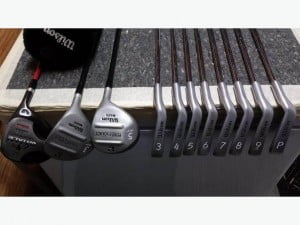What is an A Wedge?

The majority of golfers that haven’t ever heard of an A wedge already know what it is. They’ve even used it numerous times.
Simply put, an A wedge is a gap wedge, is an A wedge. Make sense? They are interchangeable. One and the same.
For those still in the dark we must raise the question, what is a gap wedge?
The gap wedge is aptly named because it fills that “gap” in the typical golf set between the pitching and sand wedges. But what is an A wedge able to do that fills that gap?
Close the Gap – Complete your Set

You’ve picked up your new set of clubs, and you’re well aware of the gap between your pitching and sand wedges.
If you’re not, don’t worry about asking the embarrassing question. I will explain it. There can be a difference in ball travel of up to (or over) 40 yards when considering whether to hit a pitching wedge or a sand wedge.
The problem with the gap comes into play when you inevitably find yourself with water, or a sand trap in your way.
Not only in your way but also right between that gap where neither a pitching nor sand wedge will work. Without having an A wedge or gap wedge, you’re in for a rough hole.
Why a Gap Wedge is also Called an A Wedge

Golfer testaments seem to belay the same variations in opinion. For general purposes, it’s safe to say that an A, attack, approach and gap wedge are all the same kind of club, and range from 50°-54°.
When shopping for these clubs it is common to see the letter A displayed. You might see a G (for the gap) on some brands or even U for utility wedge.
It makes sense that the use of the word ‘approach’ developed with respect to gap wedges. With the addition of an A wedge in their bag, golfers are better able to plan their approach to the green.
Perhaps the label ‘attack’ came from those times the A wedge is called for to get golfers out of a jam. It’s necessary to attack the ball when laying in the rough.
Read: Get the Best Driver for Low Swing Speed
The Industry Created Need to Add an A Wedge

This would give them an edge over their competitors, at least until their rivals followed suit. So the angles of pitching wedges decreased over time, but could only go so far.
The end result was this gap in distance between the sand and pitching wedge.
For a while golfers had no problem filling in the gap with older wedges, but clubs do wear over time.
Perhaps more of a contribution to the demise of this practice was the golf industry’s recognition of the need to fill this gap.
As will happen in free business anywhere a need is detected, the gap wedge was created. Nowadays there are hundreds of gap wedges for golfers to choose from.
Golfers take this opportunity as an advantage to find the right gap wedge that works for them. Of course, before any golfer started searching for their perfect club they had to ask, “What is an A wedge?”. Get an in-depth report about golf club history at usgtf.com.
What is an A Wedge Worth Now – Do You Need to Have One?

Newer or younger members of the game have never known any different.
The A wedge is quickly becoming the norm, and soon articles that answer questions like “What is an A wedge?” will be outdated.
Those older sets might still be good for the beginning golfer, but as soon as you’re prepared to upgrade to a new set of clubs, you’ll also find yourself in the market for an A wedge.
Once you’re out of the course you’ll be glad you have it.
